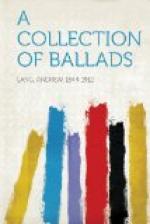This curious poem is taken from the reprint of Charles Kirkpatrick Sharpe’s tiny Ballad Book, itself now almost introuvable. It does not, to the Editor’s knowledge, occur elsewhere, but is probably authentic. The view of the Faery Queen is more pleasing and sympathetic than usual. Why mortal women were desired as nurses (except to attend on stolen mortal children, kept to “pay the Kane to hell”) is not obvious. Irish beliefs are precisely similar; in England they are of frequent occurrence.
JOHNNIE ARMSTRANG
Armstrang of Gilnockie was a brother of the laird of Mangertoun. He had a kind of Robin Hood reputation on the Scottish Border, as one who only robbed the English. Pitscottie’s account of his slaying by James V. (1529) reads as if the ballad were his authority, and an air for the subject is mentioned in the Complaint of Scotland. In Sir Herbert Maxwell’s History of Dumfries and Galloway is an excellent account of the historical facts of the case.
EDOM O’ GORDON
Founded on an event in the wars between Kingsmen and Queensmen, in the minority of James vi., while Queen Mary was imprisoned in England. “Edom” was Adam Gordon of Auchindown, brother of Huntley, and a Queen’s man. He, by his retainer, Car, or Ker, burned Towie House, a seat of the Forbes’s. Ker recurs in the long and more or less literary ballad of The Battle of Balrinnes. In variants the localities are much altered, and, in one version, the scene is transferred to Ayrshire, and Loudoun Castle. All the ballads of fire-raising, a very usual practice, have points in common, and transference was easy.
LADY ANNE BOTHWELL’S LAMENT
Tradition has confused the heroine of this piece with the wife of Bothwelhaugh, who slew the Regent Murray. That his motive was not mere political assassination, but to avenge the ill-treatment and death of his wife, seems to be disproved by Maidment. The affair, however, is still obscure. This deserted Lady Anne of the ballad was, in fact, not the wife of Bothwelhaugh, but the daughter of the Bishop of Orkney; her lover is said to have been her cousin, Alexander Erskine, son of the Earl of Mar. Part of the poem (Mr. Child points out) occurs in Broome’s play, The Northern Lass (1632). Though a popular favourite, the piece is clearly of literary origin, and has been severely “edited” by a literary hand. This version is Allan Ramsay’s.




